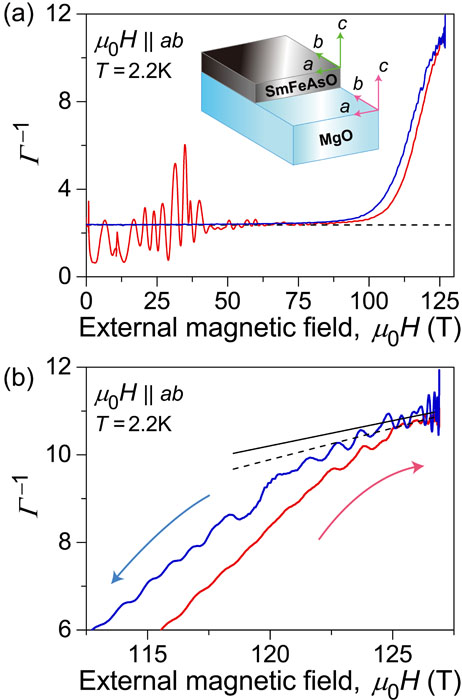High Upper Critical Field of 120 T and Small Anisotropy in Highly Hydrogen-Substituted SmFeAsO Epitaxial Film
PI of Joint-use project: H. Hiramatsu
Host lab: Kohama Group
Host lab: Kohama Group
Among iron-based bulk superconductors, the highest critical temperature (Tc) of 55 K has been recorded for the 1111-type SmFeAsO. The superconductivity emerges by electron doping through partial substitution of F− or H− in the O2− sites. Recently, we succeeded in fabrication of H-substituted SmFeAsO epitaxial thin films using topochemical reaction with binary dihydrides. The H-substituted SmFeAsO films exhibit not only high Tc, but also high critical current density (Jc), which is comparable with those of high Jc films of 122-type BaFe2As2 that is regarded as the most promising candidate among iron-based superconductors for practical application. Other than Tc and Jc, the upper critical field (μ0Hc2) and its anisotropic parameter (γ ≡ Hc2||/Hc2⊥, where the directions of the applied external magnetic fields are parallel (μ0H ||) and perpendicular (μ0H ⊥) to the ab plane of SmFeAsO.) are also the important properties for evaluation of superconductors and their applications. In this study, the electronic transport properties of the highly H-substituted SmFeAsO epitaxial film were investigated to determine the low-temperature and high-field limits of its μ0Hc2 (μ0Hc2(0)) and γ under extremely high magnetic fields generated by nondestructive (60 T) and single-turn (130 T) pulsed magnets at the ISSP.
To experimentally determine μ0Hc2(0) for μ0H || ab, we performed radio-frequency (rf) impedance measurement with the single-turn magnet up to 130 T at 2.2 K (Fig. 1). The sample resistance (R) was roughly proportional to the inverse ratio of the amplitude of the reflection rf signal to the incident rf excitation with a field-independent background (Γ−1). Even though Γ−1 remained constant with the wire resistance due to two-wire configuration between 0 and ~100 T, Γ−1 steeply increased at higher fields. An enlarged view of the high-field region in Fig. 1(a) is shown in Fig. 1(b). From the least-squares fits, clear saturation of Γ−1 was observed above ~125 T. By taking μ0H where Γ−1 became 80% of the saturated Γ−1 as μ0Hc2, μ0Hc2 of H-substituted SmFeAsO at 2.2 K was estimated to be 120 T for μ0H || ab. Because the experimentally confirmed μ0Hc2 at 2.2 K should be almost the same as its low-temperature limit μ0Hc2(0), we concluded that μ0Hc2(0) of H-substituted SmFeAsO film reaches 120 T. This is the first experimental determination of μ0Hc2for 1111-type SmFeAsO at the low-temperature and high-field limits, and it is the highest value among those of other iron-based superconductors.

Fig. 1. Impedance measurement under high magnetic fields of up to 130 T at 2.2 K. The magnetic field was generated by the single-turn magnet and applied within the ab plane. (a) Γ−1 in the field region from 0 to 130 T. The inset shows relationship between the crystallographic orientation and the sample configuration of the H-substituted SmFeAsO epitaxial film on a MgO single-crystal substrate. (b) Enlarged image of (a) in the high-field region. The constant background is indicated by a black dashed line in (a). The red and blue arrows in (b) denote the directions of the field sweep. The black dashed and solid lines in (b) are the least-squares fits of the normal-state resistance in the up and down sweeps.
Next, to determine γ, the H-substituted SmFeAsO epitaxial film was mounted on a rotator probe, where the angle between the field direction and the c axis of the film was defined as θ, and μ0H was applied with the nondestructive pulsed magnet up to 60 T. Figure 2(a) shows the R–μ0H curves at 37.5 K with different field angles θ. With increasing θ, the jump in the R–μ0H curve gradually shifted to the higher field side. This experiment revealed that although there is a non-negligible angle dependence in μ0Hc2, γ seems to be very small despite the layered structure of H-substituted SmFeAsO, which consists of individual SmO insulating and FeAs conductive layers. The θ dependence of μ0Hc2 was estimated from the θ-dependent R (Fig. 2(b)), revealing that the γ around Tc is ~2. This small γis comparable with those of MgB2 and 122-type BaFe2As2, and almost half of that of F-substituted SmFeAsO (γ > 4). The small γ value of H-substituted SmFeAsO mainly originates from realization of three-dimensional superconductivity owing to high H incorporation.
In summary, we clarified the remarkable and unique characteristics in the H-substituted SmFeAsO epitaxial film such as the high μ0Hc2(0) of 120 T and relatively isotropic γ (~2) under extremely high magnetic fields generated by nondestructive and single-turn pulsed magnets at the ISSP [1]. Owing to the high and nearly isotropic μ0Hc2, as well as the high Tc and high Jc, H-substituted SmFeAsO is a promising candidate for superconducting applications, such as the wires and tapes for cables and high-field electromagnets.
References
- [1] K. Hanzawa, J. Matsumoto, S. Iimura, Y. Kohama, H. Hiramatsu, and H. Hosono, Phys. Rev. Mater. 6, L111801 (2022).

